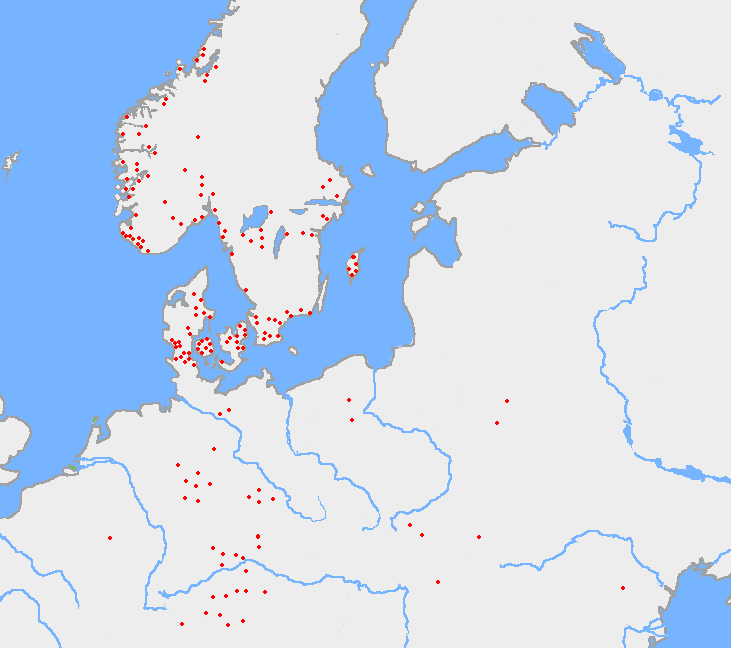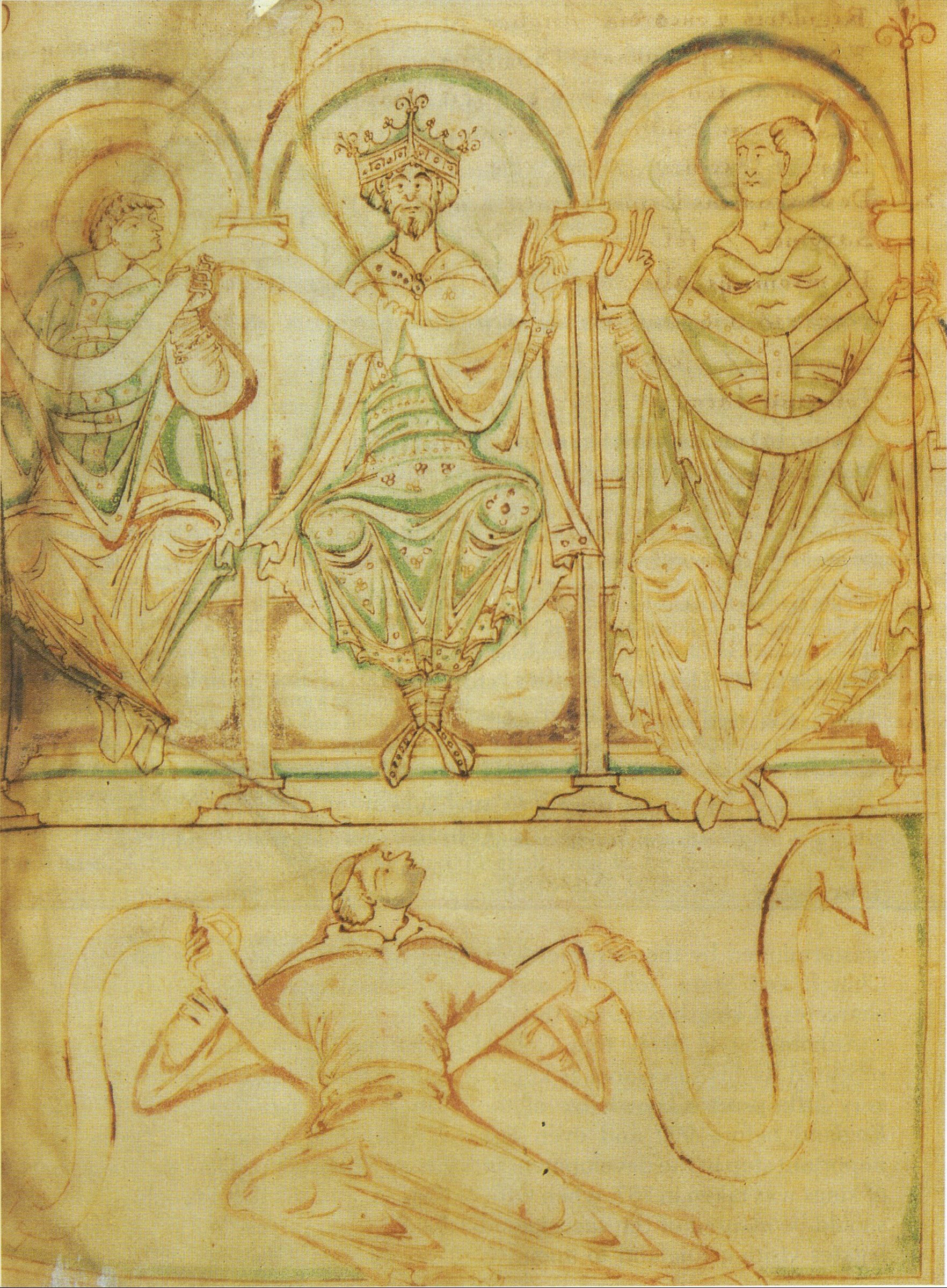|
Alu (runic)
The sequence ''alu'' () is found in numerous Elder Futhark runic inscriptions of Germanic Iron Age Scandinavia (and more rarely in early Anglo-Saxon England) between the 3rd and the 8th century. The word usually appears either alone (such as on the Elgesem runestone) or as part of an apparent formula (such as on the Lindholm "amulet" (DR 261) from Scania, Sweden). The symbols represent the runes Ansuz, Laguz, and Uruz. The origin and meaning of the word are matters of dispute, though a general agreement exists among scholars that the word represents an instance of historical runic magic or is a metaphor (or metonym) for it.Macleod (2006:24). It is the most common of the early runic charm words.Macleod (2006:1009) The word disappears from runic inscriptions shortly after the Migration Period, even before the Christianization of Scandinavia.Macleod (2006:100-101). It may have lived on beyond this period with an increasing association with ale, appearing in stanzas 7 and 19 of t ... [...More Info...] [...Related Items...] OR: [Wikipedia] [Google] [Baidu] |
Elder Futhark
The Elder Futhark (or Fuþark), also known as the Older Futhark, Old Futhark, or Germanic Futhark, is the oldest form of the runic alphabets. It was a writing system used by Germanic peoples for Northwest Germanic dialects in the Migration Period. Inscriptions are found on artifacts including jewelry, amulets, plateware, tools, and weapons, as well as runestones in Scandinavia, from the 2nd to the 10th centuries. In Scandinavia, beginning in the late 8th century, the script was simplified to the Younger Futhark, while the Anglo-Saxons and Frisians instead extended it, giving rise to the Anglo-Saxon futhorc. Both the Anglo-Saxon futhorc and the Younger Futhark remained in use during the Early and the High Middle Ages respectively, but knowledge of how to read the Elder Futhark was forgotten until 1865, when it was deciphered by Norwegian scholar Sophus Bugge. Description The Elder Futhark (named after the initial phoneme of the first six rune names: F, U, Þ, A, R and K) has ... [...More Info...] [...Related Items...] OR: [Wikipedia] [Google] [Baidu] |
Sigrdrífumál
(also known as ) is the conventional title given to a section of the ''Poetic Edda'' text in . It follows without interruption, and it relates the meeting of Sigurðr with the valkyrie Brynhildr, here identified as ("driver to victory"). Its content consists mostly of verses concerned with runic magic and general wisdom literature, presented as advice given by Sigrdrífa to Sigurd. The metre is , except for the first stanza. The end is in the lost part of the manuscript but it has been substituted from younger paper manuscripts. The describes the scene and contains some of the poem. Name The compound means "driver to victory" occurs both as a common noun, a synonym of , and as a proper name of the valkyrie named Hild or Brynhild in the Prose Edda. H. Reichert, "Sigrdrifa (Brynhildr)" in: McConnell et al. (eds.), ''The Nibelungen Tradition: An Encyclopedia'', Routledge (2013) p. 119 H. Reichert, "Zum Sigrdrífa-Brünhild-Problem" in: Mayrhofer et al. (eds.), ''Antiquitate ... [...More Info...] [...Related Items...] OR: [Wikipedia] [Google] [Baidu] |
Etruscan Language
Etruscan () was the language of the Etruscan civilization, in Italy, in the ancient region of Etruria (modern Tuscany, western Umbria, northern Latium, Emilia-Romagna, Veneto, Lombardy and Campania). Etruscan influenced Latin but was eventually completely superseded by it. The Etruscans left around 13,000 inscriptions that have been found so far, only a small minority of which are of significant length; some bilingual inscriptions with texts also in Latin, Greek, or Phoenician; and a few dozen purported loanwords. Attested from 700 BC to AD 50, the relation of Etruscan to other languages has been a source of long-running speculation and study, with its being referred to at times as an isolate, one of the Tyrsenian languages, and a number of other less well-known theories. The consensus among linguists and Etruscologists is that Etruscan was a Pre–Indo-European, and a Paleo-European language and is closely related to the Raetic language that was spoken in the Alps,Schumacher, S ... [...More Info...] [...Related Items...] OR: [Wikipedia] [Google] [Baidu] |
Raetia
Raetia ( ; ; also spelled Rhaetia) was a province of the Roman Empire, named after the Rhaetian people. It bordered on the west with the country of the Helvetii, on the east with Noricum, on the north with Vindelicia, on the south-west with Transalpine Gaul and on the south with Venetia et Histria, a region of Roman Italy. It thus comprised the districts occupied in modern times by eastern and central Switzerland (containing the Upper Rhine and Lake Constance), southern Germany (Bavaria and most of Baden-Württemberg), Vorarlberg and the greater part of Tyrol in Austria, and part of northern Lombardy in Italy. The region of Vindelicia (today eastern Württemberg and western Bavaria) was annexed to the province at a later date than the others. The northern border of Raetia during the reigns of emperors Augustus and Tiberius was the River Danube. Later the Limes Germanicus marked the northern boundary, stretching for 166 km north of the Danube. Raetia linked to Italy ac ... [...More Info...] [...Related Items...] OR: [Wikipedia] [Google] [Baidu] |
Germanic Paganism
Germanic paganism or Germanic religion refers to the traditional, culturally significant religion of the Germanic peoples. With a chronological range of at least one thousand years in an area covering Scandinavia, the British Isles, modern Germany, and at times other parts of Europe, the beliefs and practices of Germanic paganism varied. Scholars typically assume some degree of continuity between Roman-era beliefs and those found in Norse paganism, as well as between Germanic religion and reconstructed Indo-European religion and post-conversion folklore, though the precise degree and details of this continuity are subjects of debate. Germanic religion was influenced by neighboring cultures, including that of the Celts, the Romans, and, later, by Christian religion. Very few sources exist that were written by pagan adherents themselves; instead, most were written by outsiders and can thus can present problems for reconstructing authentic Germanic beliefs and practices. Some basic ... [...More Info...] [...Related Items...] OR: [Wikipedia] [Google] [Baidu] |
Rundata
The Scandinavian Runic-text Data Base ( sv, Samnordisk runtextdatabas) is a project involving the creation and maintenance of a database of runic inscriptions. The project's goal is to comprehensively catalog runestones in a machine-readable way for future research. The database is freely available via the Internet with a client program, called Rundata, for Microsoft Windows. For other operating systems, text files are provided or a web browser can be used to interact with the web applicatioRunor History The origin of the Rundata project was a 1986 database of Swedish inscriptions at Uppsala University for use in the Scandinavian Languages Department. At a seminar in 1990 it was proposed to expand the database to cover all Nordic runic inscriptions, but funding for the project was not available until a grant was received in 1992 from the ''Axel och Margaret Ax:son Johnsons'' foundation. The project officially started on January 1, 1993 at Uppsala University. After 1997, the proje ... [...More Info...] [...Related Items...] OR: [Wikipedia] [Google] [Baidu] |
Proto-Germanic
Proto-Germanic (abbreviated PGmc; also called Common Germanic) is the reconstructed proto-language of the Germanic branch of the Indo-European languages. Proto-Germanic eventually developed from pre-Proto-Germanic into three Germanic branches during the fifth century BC to fifth century AD: West Germanic, East Germanic and North Germanic, which however remained in contact over a considerable time, especially the Ingvaeonic languages (including English), which arose from West Germanic dialects and remained in continued contact with North Germanic. A defining feature of Proto-Germanic is the completion of the process described by Grimm's law, a set of sound changes that occurred between its status as a dialect of Proto-Indo-European and its gradual divergence into a separate language. As it is probable that the development of this sound shift spanned a considerable time (several centuries), Proto-Germanic cannot adequately be reconstructed as a simple node in a tree model but ... [...More Info...] [...Related Items...] OR: [Wikipedia] [Google] [Baidu] |
Edgar Charles Polomé
Edgar is a commonly used English given name, from an Anglo-Saxon name ''Eadgar'' (composed of '' ead'' "rich, prosperous" and ''gar'' "spear"). Like most Anglo-Saxon names, it fell out of use by the later medieval period; it was, however, revived in the 18th century, and was popularised by its use for a character in Sir Walter Scott's ''The Bride of Lammermoor'' (1819). People with the given name * Edgar the Peaceful (942–975), king of England * Edgar the Ætheling (c. 1051 – c. 1126), last member of the Anglo-Saxon royal house of England * Edgar of Scotland (1074–1107), king of Scotland * Edgar Angara, Filipino lawyer * Edgar Barrier, American actor * Edgar Baumann, Paraguayan javelin thrower * Edgar Bergen, American actor, radio performer, ventriloquist * Edgar Berlanga, American boxer * Edgar H. Brown, American mathematician * Edgar Buchanan, American actor * Edgar Rice Burroughs, American author, creator of ''Tarzan'' * Edgar Cantero, Spanish author in Catalan, Sp ... [...More Info...] [...Related Items...] OR: [Wikipedia] [Google] [Baidu] |
Beowulf
''Beowulf'' (; ang, Bēowulf ) is an Old English epic poem in the tradition of Germanic heroic legend consisting of 3,182 alliterative lines. It is one of the most important and most often translated works of Old English literature. The date of composition is a matter of contention among scholars; the only certain dating is for the manuscript, which was produced between 975 and 1025. Scholars call the anonymous author the "''Beowulf'' poet". The story is set in pagan Scandinavia in the 6th century. Beowulf, a hero of the Geats, comes to the aid of Hrothgar, the king of the Danes, whose mead hall in Heorot has been under attack by the monster Grendel. After Beowulf slays him, Grendel's mother attacks the hall and is then defeated. Victorious, Beowulf goes home to Geatland and becomes king of the Geats. Fifty years later, Beowulf defeats a dragon, but is mortally wounded in the battle. After his death, his attendants cremate his body and erect a tower on a headland in ... [...More Info...] [...Related Items...] OR: [Wikipedia] [Google] [Baidu] |
Ealuscerwen
''Ealuscerwen'' (''ealuscerƿen'', ) is an Old English hapax legomenon found in ''Beowulf'' (verse 769). Since it appears to refer to a part of Anglo-Saxon drinking ritual, it has commanded a lot of scholarly attention. The context in which it appears is: Slade in a footnote states that "the kenning (if it is one) is obscure". From the context it is clear that "being in ''ealuscerwen''" is an unpleasant state. The first part of the compound is clearly ''ealu'' "ale". The second part, ''scerwen'' is less clear. A simplex ''*scerwen'' is unknown. There is a compound verb ''be-scerwen'', meaning "to deprive". Klaeber conjectures that "''-scerwen'', related to ''*scerwan'' 'grant', 'allot' (''bescerwan'' ='deprive') - 'dispensing of ale', or, in a pregnant sense, of 'bitter or fateful drink' might have come to be used as a figurative expression for 'distress'". Hoops favours "deprivation of ale". But Brodeur (chap 2 n.8) objects to this, pointing out that if ''bescerwan'' means "depri ... [...More Info...] [...Related Items...] OR: [Wikipedia] [Google] [Baidu] |




.jpg)
